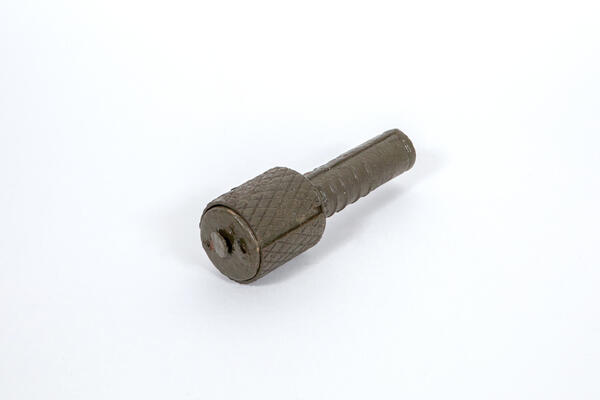Vladislav Laboskin, a member of the Noyabrsk joint search party ‘Vitalis’, donated the Dyakonov hand grenade of the 1933 pattern (RGD-33) to the museum. In 2006-2008, the party conducted archaeological excavations on the battlefields of the Great Patriotic War of 1941-1945 in the village of Karpovo, Tver Oblast.
The grenade is made of metal, painted in green and varnished on top. A metal rotary valve closes the fuze-hole. The grenade is empty inside. The explosive material was removed from it when it was deactivated. In the lower part of the handle, a triangle mark and the designations ‘ZKM’ and ‘41’ have been preserved.
Weapon designer Mikhail Dyakonov developed the RGD-33 in 1933. He based it on a fragmentation hand grenade of the 1914 model designed by Vladimir Rdultovsky, which was in service in the Russian army during the First World War.
The explosive material, most often TNT (Trinitrotoluene), was placed in the cylindrical warhead of the RGD-33. To enhance the damaging effect, several thin steel fragments were placed inside. In the center of the body was a sleeve with the valve, where the fuze was inserted.
Soldiers were given the RGD-33 grenades disassembled, in separate boxes with fuzes, handles, and warheads. They screwed the handles onto the warheads and put them in grenade pouches. A special washer did not allow the grenade to unscrew. The fuzes were kept separately. To prepare the RGD-33 for combat, it was necessary to pull the spring and the striker of the handle and make the grenade safe by turning the safety pin, then to put the fuze into the warhead and close it with the valve.
After aiming, a soldier turned the safety pin and threw the grenade. From the swing, the spring-loaded handle detached and stroked the fuze, starting the burning process. It was recommended to throw the grenade no closer than 35-40 meters. It took about 4 seconds from the launch to the explosion.
The RGD-33 belonged to the anti-personnel fragmentation hand grenades of the double action type and was intended to hit enemy infantry with the fragments. The ‘double-action type’ meant that it could be used for offensive and defensive purposes. During the attack, lighter fragments scattered within a 15-meter radius. For defense, a thick metal fragmentation jacket was wrapped around the grenade; these heavier fragments could scatter within a 30-meter radius.
The grenade is made of metal, painted in green and varnished on top. A metal rotary valve closes the fuze-hole. The grenade is empty inside. The explosive material was removed from it when it was deactivated. In the lower part of the handle, a triangle mark and the designations ‘ZKM’ and ‘41’ have been preserved.
Weapon designer Mikhail Dyakonov developed the RGD-33 in 1933. He based it on a fragmentation hand grenade of the 1914 model designed by Vladimir Rdultovsky, which was in service in the Russian army during the First World War.
The explosive material, most often TNT (Trinitrotoluene), was placed in the cylindrical warhead of the RGD-33. To enhance the damaging effect, several thin steel fragments were placed inside. In the center of the body was a sleeve with the valve, where the fuze was inserted.
Soldiers were given the RGD-33 grenades disassembled, in separate boxes with fuzes, handles, and warheads. They screwed the handles onto the warheads and put them in grenade pouches. A special washer did not allow the grenade to unscrew. The fuzes were kept separately. To prepare the RGD-33 for combat, it was necessary to pull the spring and the striker of the handle and make the grenade safe by turning the safety pin, then to put the fuze into the warhead and close it with the valve.
After aiming, a soldier turned the safety pin and threw the grenade. From the swing, the spring-loaded handle detached and stroked the fuze, starting the burning process. It was recommended to throw the grenade no closer than 35-40 meters. It took about 4 seconds from the launch to the explosion.
The RGD-33 belonged to the anti-personnel fragmentation hand grenades of the double action type and was intended to hit enemy infantry with the fragments. The ‘double-action type’ meant that it could be used for offensive and defensive purposes. During the attack, lighter fragments scattered within a 15-meter radius. For defense, a thick metal fragmentation jacket was wrapped around the grenade; these heavier fragments could scatter within a 30-meter radius.



